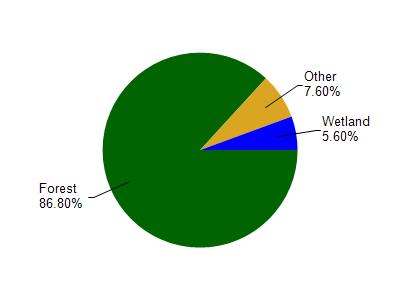Bayfield
Yes
No
No
Fish and Aquatic Life
Overview
The North Fork of Whittlesey Creek begins as sluggish swamp drainage at the boundary of the Chequamegon National Forest. The creek flows through a low swampy area before the gradient increases, carving a streambed that is severely eroded, with steep banks that rise as high as one hundred feet. The raw, red clay banks are extremely unstable and subject to slumping. This stream supports a Class I trout fishery and migratory runs of trout and salmon species from its confluence with Whittlesey Creek upstream about two miles to the road crossing in Section 20. Upstream from the road crossing, the stream supports a Class II trout fishery. The headwaters area drains a region that was recently clearcut, then passes through agricultural areas and pasture land before reaching Whittlesey Creek. This stream is a part of the Whittlesey Creek Small-Scale Priority Watershed Project.
Wisconsin Trout Streams lists the Class I portion of the creek as running from the road crossing to Section 20 downstream. It should read the road crossing in Section 20 downstream.
Date 1999
Author Aquatic Biologist
Condition
Wisconsin has over 84,000 miles of streams, 15,000 lakes and milllions of acres of wetlands. Assessing the condition of this vast amount of water is challenging. The state's water monitoring program uses a media-based, cross-program approach to analyze water condition. An updated monitoring strategy (2015-2020) is now available. Compliance with Clean Water Act fishable, swimmable standards are located in the Executive Summary of Water Condition in 2018. See also the 'monitoring and projects' tab.
Reports
Management Goals
Wisconsin's Water Quality Standards provide qualitative and quantitative goals for waters that are protective of Fishable, Swimmable conditions [Learn more]. Waters that do not meet water quality standards are considered impaired and restoration actions are planned and carried out until the water is once again fishable and swimmable
Management goals can include creation or implementation of a Total Maximum Daily Load analysis, a Nine Key Element Plan, or other restoration work, education and outreach and more. If specific recommendations exist for this water, they will be displayed below online.
Monitoring
Monitoring the condition of a river, stream, or lake includes gathering physical, chemical, biological, and habitat data. Comprehensive studies often gather all these parameters in great detail, while lighter assessment events will involve sampling physical, chemical and biological data such as macroinvertebrates. Aquatic macroinvertebrates and fish communities integrate watershed or catchment condition, providing great insight into overall ecosystem health. Chemical and habitat parameters tell researchers more about human induced problems including contaminated runoff, point source dischargers, or habitat issues that foster or limit the potential of aquatic communities to thrive in a given area. Wisconsin's Water Monitoring Strategy was recenty updated.
Grants and Management Projects
| Project Name (Click for Details) | Year Started |
|---|
|
|
Monitoring Projects
| WBIC | Official Waterbody Name | Station ID | Station Name | Earliest Fieldwork Date | Latest Fieldwork Date | View Station | View Data |
|---|
| 2887500 | North Fork Whittlesey Creek | 10013525 | North Fork Whittlesey Creek- Downstream Of Cozy Corner Road- Station #1 | 6/5/2017 | 10/20/2017 | Map | Data |
| 2887500 | North Fork Whittlesey Creek | 10013514 | N Fork Whittlesey Creek- Turn In At 73200 Of Fr 500 Keep Right Timber Rd .3 Mile From Split-Stati#2 | 10/31/2005 | 10/31/2005 | Map | Data |
| 2887500 | North Fork Whittlesey Creek | 10036367 | North Fork Whittlesey Creek - Area of Open Water | 6/29/2010 | 9/1/2010 | Map | Data |
| 5500531 | Unnamed | 10036367 | North Fork Whittlesey Creek - Area of Open Water | 6/29/2010 | 9/1/2010 | Map | Data |
|

Watershed Characteristics
North Fork Whittlesey Creek is located in the Bayfield Peninsula Southeast watershed which is 301.48 mi². Land use in the watershed is primarily forest (86.80%), wetland (5.60%) and a mix of grassland (4.10%) and other uses (3.50%). This watershed has 453.79 stream miles, 291,749.17 lake acres and 6,560.31 wetland acres.
Nonpoint Source Characteristics
This watershed is ranked Not Ranked for runoff impacts on streams, Not Available for runoff impacts on lakes and Low for runoff impacts on groundwater and therefore has an overall rank of Low. This value can be used in ranking the watershed or individual waterbodies for grant funding under state and county programs.However, all waters are affected by diffuse pollutant sources regardless of initial water quality. Applications for specific runoff projects under state or county grant programs may be pursued. For more information, go to surface water program grants.